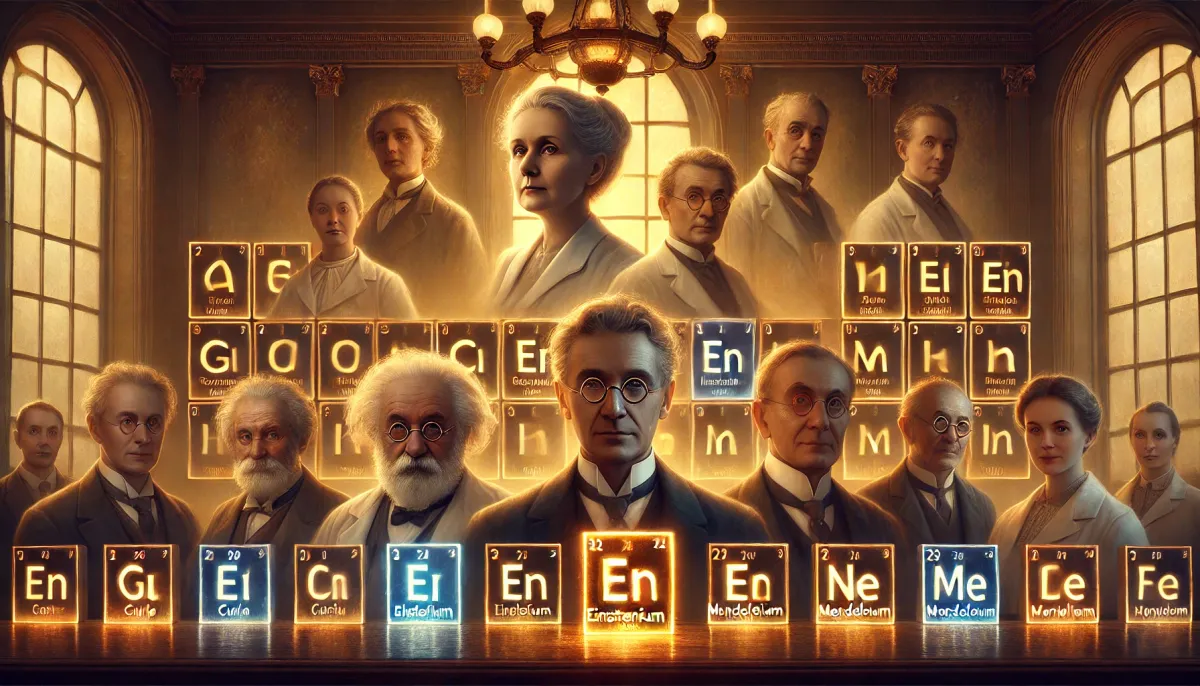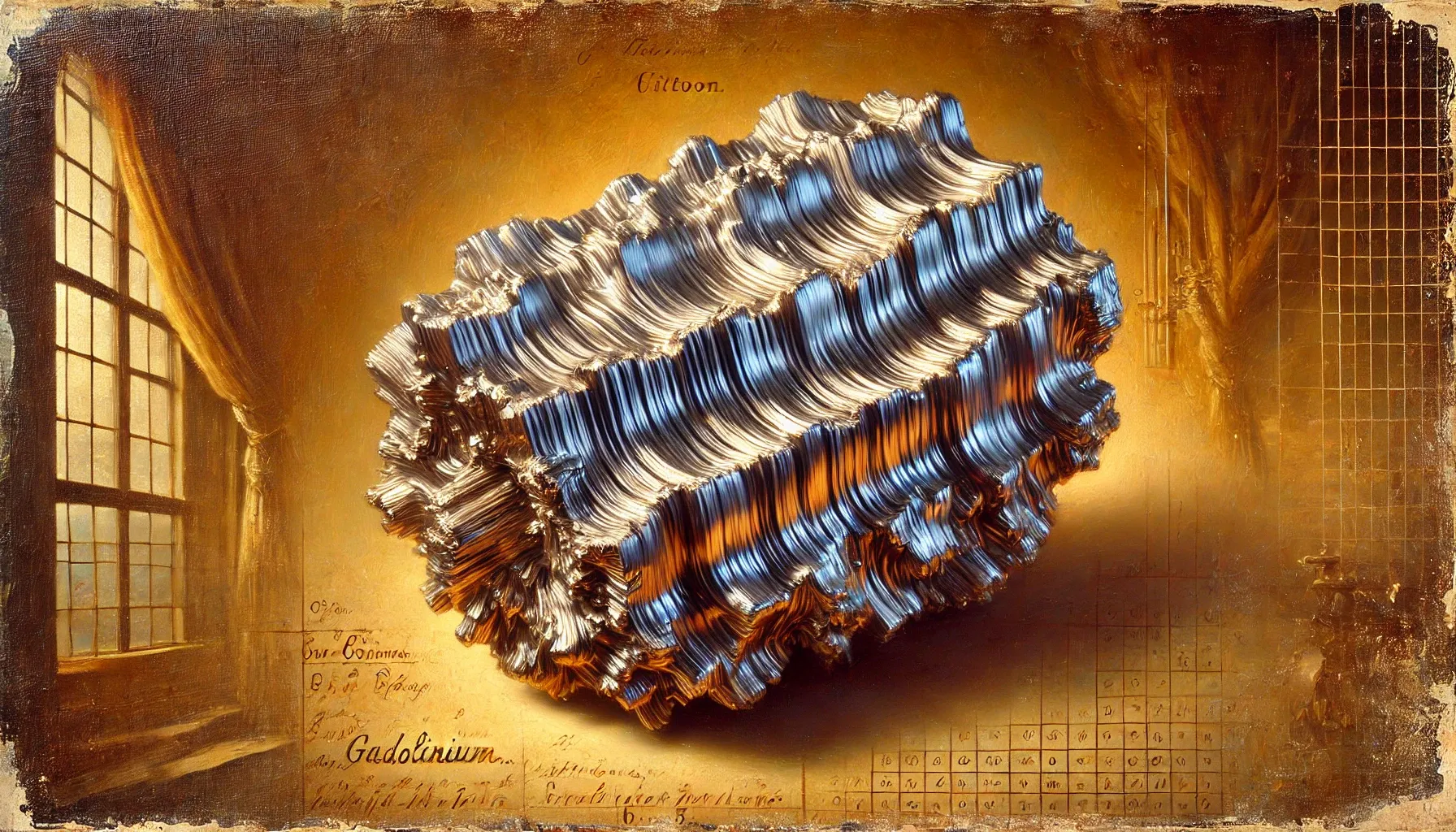Chemical Elements Named After Scientists and Other People
Elements of the periodic table are sometimes named after people. Often intentionally, and sometimes accidentally. Read the details in this article.

Source of the Periodic Table Elements List
There exists, as it turns out, a book called “Book of Lists” [1]. This book contains over 500 lists on various topics.
Regular blog readers might raise their eyebrows to the stratosphere right now. Why am I writing about it here? The book is already mentioned at least once every two weeks, and there's even a whole post dedicated to its various editions, of which there are more than a hundred!
However, the “Book of Lists” I'm talking about is not the original “The Book of Lists” [2]. The book mentioned in the first paragraph was published in England in 2005. It contains a list of the periodic table elements by Dmitri Mendeleev named after famous people, from scientists to explorers and landowners. You can find the modern version of the famous visualization called the IUPAC Periodic Table of the Elements on the International Union of Pure and Applied Chemistry website.
While the original list includes only 8 names, the internet revealed a total of 19. Let's take a closer look at them.
So, Here's the List of Chemical Elements Named After Scientists and Famous People
By the way, not all element names are directly associated with people. Some got their names eternalized indirectly.
- Samarium
- Gadolinium
- Americium
- Curium
- Berkelium
- Einsteinium
- Fermium
- Mendelevium
- Nobelium
- Lawrencium
- Rutherfordium
- Seaborgium
- Bohrium
- Meitnerium
- Roentgenium
- Copernicium
- Flerovium
- Livermorium
- Oganesson
All the images from below are generated by the AI and do not reflect the real people and elements that accurately.
Samarium

A metal discovered in 1878 by the French chemist Marc Delafontaine and in 1879 by Lecoq de Boisbaudran. It was found in the mineral samarskite, one of the chemical compounds, through spectroscopy. Samarskite itself was named after Vasily Samarsky-Bykhovets, a Russian mining engineer and colonel from Tomsk.
Thus, we can say that Samarium inherited its name. This was the very first element named after a person.
Gadolinium

The origin of this element's name is similar to that of samarium. Finnish chemist Johan Gadolin discovered the mineral that would later be named gadolinite. Almost a century later, in 1880, Swiss chemist Jean de Marignac discovered a new element in this mineral and named it gadolinium.
Not right away, but there were many other elements yet to come.
Americium

This element was artificially created in 1944 in Chicago, USA, by Glenn Seaborg. This element's name was inspired indirectly by a person, as it was meant to symbolize America in the same way europium represents Europe.
As we know, America was named after Amerigo Vespucci, hence why this element made it into the list. Such an indirect connection. Incidentally, americium is a radioactive metal.
Curium

Also discovered in 1944 and also by Seaborg, but with colleagues Ralph James and Albert Ghiorso. It was named in honor of Nobel Prize laureates Marie and Pierre Curie. Curium is radioactive. This element was produced by the neutron bombardment of plutonium in a nuclear reactor.
Berkelium

Similar to americium, this element was named after a city. However, the city itself was named after philosopher George Berkeley. Seaborg, Ghiorso, this time joined by Stanley Thompson and Kenneth Street, discovered berkelium in 1949.
Einsteinium, Borned in Nuclear Reactions
Found in significant quantities after the first thermonuclear bomb test “Ivy Mike” on November 1, 1952. The element was detected in the explosion's fallout, identified by Albert Ghiorso, whom we already know.
There is some irony in the fact that einsteinium was created as a result of the nuclear reactions. Albert Einstein himself thought that participating in the atomic bomb creation was “One Great Mistake in My Life” [3].
Fermium
Also discovered by Ghiorso in the fallout from the first thermonuclear bomb test, a significant event in the history of nuclear physics. Named after the renowned theoretical physicist Enrico Fermi.
Mendelevium
The contribution of Dmitri Mendeleev to chemistry could not go unrecognized, hence mendelevium. Although Mendeleev already has a whole table named after him, one more element couldn't hurt. The team of chemists mentioned above irradiated einsteinium to discover this element in 1955.
Nobelium
Initially detected by a group of scientists from Stockholm in 1957. Unfortunately, this discovery was not confirmed in other laboratories, and for some time, the fate of Nobelium, named after Alfred Nobel, was uncertain. Parallel research from 1963-1967 in Berkeley and Dubna, USSR, finally established nobelium in the system of elements.
Lawrencium
Discovered concurrently in Berkeley, where it was named “Lawrencium” in honor of the inventor of the cyclotron, physicist Ernest Lawrence, and in Dubna, where it was named “Rutherfordium”. The discovery occurred between 1961 and 1965.
Rutherfordium
Synthesized in 1964 in Dubna. The name proposed by Soviet researchers for the previous element was not shelved for long. The very next element was named after Ernest Rutherford. However, it's worth noting that, since the USSR already had its own rutherfordium, this element was sometimes referred to as Kurchatovium in honor of the renowned physicist Igor Kurchatov.
Beyond that, it's the first of the superheavy elements.
Seaborgium
Considering how many elements Glenn Seaborg discovered, it was only fitting that one would bear his name. The element was dedicated to this active researcher in 1997, though it had been synthesized in 1974. Notably, Seaborg was still alive at the time, marking the first instance of a living person having an element named after them. Not many scientists can boast of such an achievement. Although, at least one other can. Incidentally, Ghiorso has yet to have an element named after him.
Bohrium
This element was first synthesized in 1976 by Yuri Oganessian's group in Dubna. Named after Niels Bohr. The name “bohrium” was preceded by the proposal “nielsbohrium,” but this compounded naming was rejected.
Meitnerium
First obtained in Darmstadt, Germany, in 1982. Named in honor of Austrian physicist and radiochemist Lise Meitner.
Roentgenium
Also produced in Darmstadt in 1994. The name may sound familiar since Wilhelm Roentgen lent his name both to the radiation (👋, X-Ray).
Copernicium
Germany continued its element discoveries, producing this one in 1996. It's named after astronomer Nicolaus Copernicus.
Flerovium
Back to Dubna, where this new element was synthesized in 1998. It was named after Georgy Flyorov, one of the founders of the Joint Institute for Nuclear Research in Dubna, an academician of the USSR Academy of Sciences. Today the Joint Institute is known as Flerov Laboratory of Nuclear Reactions.
Livermorium
Livermorium was synthesized in 2000 at the Joint Institute for Nuclear Research (Dubna, Russia) in collaboration with the Lawrence Livermore National Laboratory (USA), the Research Institute of Atomic Reactors (Dimitrovgrad, Russia), and ‘Electrokhimpribor' (Lesnoy, Russia). While the element was named after the laboratory, the town of Livermore itself was named after Robert Livermore, a prominent landowner in California. He might be the least science-related figure in this list.
Oganesson
The last element to this moment named after a scientist.
Also synthesized through collaborative efforts of Russian and American researchers. This occurred in 2002, and the element was named after Yuri Oganessian, mentioned earlier. He became the second person to have an element named after them while still alive.
Oganesson is the heaviest element known to this date.
Conclusion
The oldest elements’ names are built on the Greek word or the Latin word. There are names called using the mythological concept (👋 Uranium, named after the Greek god, the character as well as an astronomical object). Some elements bear names of countries or geographical regions. These recently discovered elements’ names reflect an intriguing history of collaboration between scientists and politicians around the world.
We can also notice that the tradition of naming elements after the famous scientists gain more popularity as elements become created rather than discovered.
Readers might note that scientists synthesized the latest elements rather than discovering them in nature. This is due to the unavailability of certain conditions required for new elements to form within our solar system. Additionally, some synthetic elements are highly unstable, necessitating advanced and powerful equipment for their creation, which is why we don’t see them in nature. Chemistry today, however, is capable of building them in powerful machines.
There are also undiscovered elements, but the predicted ones. E.g., the 125th element is expected to be a transitioned metal. Possibly, rather soon, Albert Ghiorso’s name will move out of the proposed names and become eternalized in one of the newly synthesized elements.
Was it interesting to learn about elements named after famous people? Subscribe to the “So List” blog — there are many more amazing lists and checklists in the world. You'll also learn how to solve many issues with these simple yet powerful tools.
List of Links
[1] Christopher Rigby, “Book of Lists,” ISBN 1-84236-622-X
[2] David Wallechinsky, Irving Wallace, Amy Wallace, “The Book of Lists,” ISBN 978-0-688-03183-1
[3] Albert Einstein’s Role in the Atomic Bomb Was the “One Great Mistake in My Life” from the “Yahoo! News” website
[4] “Are There Any Undiscovered Elements?” from “ThoughtCo.”



